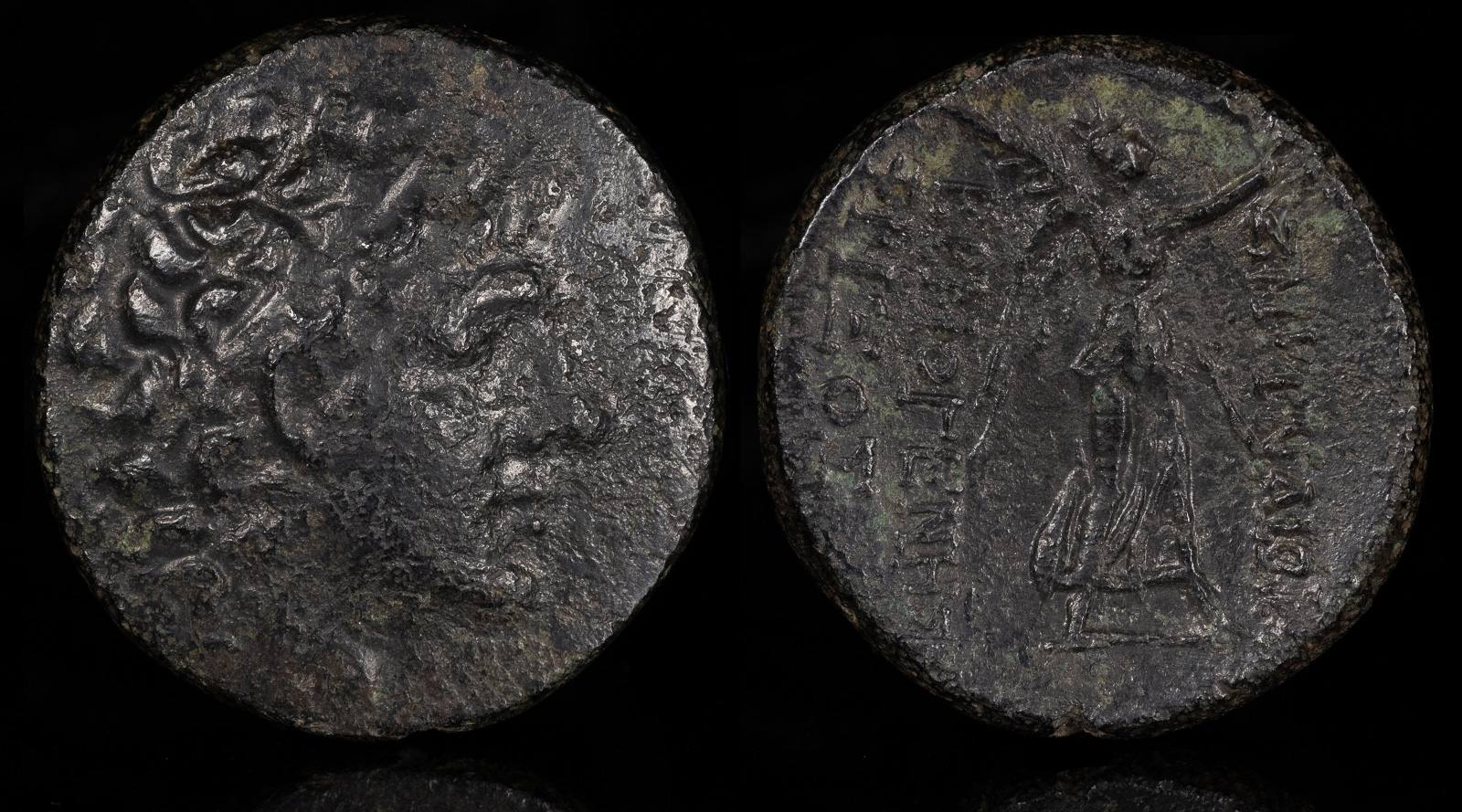
Kings of Pontos. Mithradates VI (120-63 BC)
Ionia. Smyrna. Hermogenes and Phrixos, magistrates
85-75 BCE 24.14mm 12.54g
Obverse: Diademed head of Mithradates VI right
Reverse: ZMYPNAIΩN – EPMOΓΕΝΗΣ – ΦΡΙΞΟΣ, Nike standing right, holding wreath and palm frond
SNG Copenhagen 1206
Ex Marc Breitsprecher
The coinage of earliest Pontic kings are considered works of art and go for tens of thousands. My example is far more modest and comes from Mithradates VI, who gave the Roman Empire a good run for their money.
Birth of Mithridates I Ctistes, who founded the Pontic Kingdom.
Mithridates I is slain in Kios after appearing to shift his allegiance from Antigonos Monophthalmos to Kassander. He had also ruled Myrleia.
Mithridates I Ctistes declares himself king of the Pontic Kingdom.
Death of Mithridates I Ctistes of the Pontic Kingdom. Ariobarzanes of Pontos becomes king.
Approximate death year of Ariobarzanes of Pontos, who had taken the city of Amisos. He is succeeded by Mithridates II of Pontos.
Death of Mithridates II of Pontos. He is succeeded by his son Mithridates III.
Approximate death of Mithridates III of Pontos. He is succeeded by Pharnakes I of Pontos.
Mithridates V Euergetes is born in Amaseia. He later becomes a key ruler of Pontus and expands the kingdom’s influence.
Pharnakes I takes Sinope, which then becomes the capital of the Pontic Kingdom.
Pharnakeia is founded by Pharnakes I of Pontos.
Approximate death of Pharnakes I of Pontos. Mithridates IV of Pontos becomes king.
Death of Mithridates IV of Pontos. Mithridates V becomes king.
Death of Mithridates V of Pontos. Mithridates VI becomes king.
Ariarathes VI is murdered by Mithridates VI. Cappadocia is then seized by Nikomedes III of Bithynia. Mithridates then takes the kingdom back and installs Ariarathes VII, this ends the Ariarathid line.
Odessos places itself under Mithridates VI.
Mithridates VI executes Ariarathes VII, King of Cappadocia, and installs his own nine-year-old son, Ariarathes IX, as King of Cappadocia.
Chalkis is used by Mithridates VI for invading Greece.
Mithridates VI’s troops take Delos and ransack it.
With the help of Mithridates VI, the inhabitants of Kaunos kill all Romans in their city.
Kos is plundered by Mithridates VI of Pontus during his campaigns against Rome.
Patara is besieged by Mithridates VI.
Mithridates VI makes Pergamon his headquarters of his war against Rome.
Mithridates VI stays for some time at Stratonikeia and marries one of its citizens.
During the First Mithridatic War, the Roman general Sulla sacks Aegina as he attempts to defeat Mithridates VI of Pontus.
Taxiles, a general of Mithridates VI, attempts to take Elataia but the city successfully resists. The Romans declare Elataia a free city in gratitude.
Sulla uses the Olympic Games at Olympia to celebrate his victory over Mithridates VI.
Deiotaros of Galatia assists the Romans against Mithridates VI.
Ilion sides with the Roman general Lucullus against Mithridates VI.
Kyzikos is defended by the Romans against a siege by Mithridates VI.
Delos destroyed again by pirates under Athenodoros, an ally of Mithridates VI.
Phanagoria, Nymphaion, Chersonesos, and Theodosia revolt against Mithridates VI.
Mithridates VI attempts suicide but fails because he has built up a tolerance. He then requests his body guard to kill him by sword. Pharnakes II becomes king of the Pontic Kingdom.
Julius Caesar quickly defeats Pharnakes II of the Kingdom of Pontus at Zela, leading to the famous phrase “veni, vidi, vici.”
Pharnakes II retreats north and takes Pantikapaion and Theodosia.
Pharnakes II, king of the Pontic kingdom, dies in battle against Asander. His daughter Dynamis becomes queen.
Death of Queen Dynamis, thus ending the Pontic line.